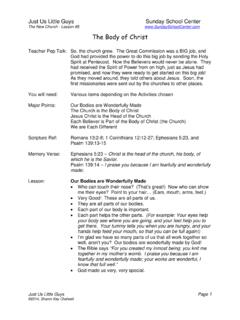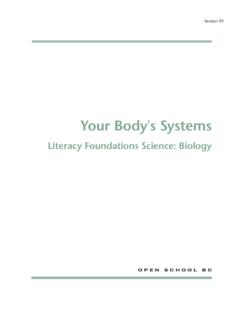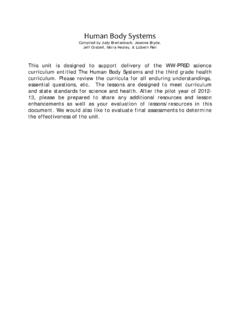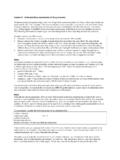Transcription of Lesson Plan – Sexual & Reproductive Anatomy and …
1 Lesson Plan Sexual & Reproductive Anatomy and Physiology part ITOPIC: Sexual & Reproductive Anatomy and Physiology part ITARGET AGE RANGE: 9 15 TIME: 45 minutesSUBJECT: Life SkillsIDEAL NUMBER OF LEARNERS: 25 40 WHAT ADVANCE PREPARATION, IF ANY, IS REQUIRED OF THE TEACHER FOR THIS Lesson ? Review Teacher Background on Reproductive Systems due to large number of terms and OUTCOMES: By the end of this Lesson learners will be able to:1) Locate and name at least five parts of each of the male and female Reproductive systems. [knowledge]LIFE SKILLS DEMONSTRATED IN THIS Lesson :1) Seek information about Sexual and Reproductive Anatomy . RESOURCE MATERIALS FOR TEACHER: Teacher Background on Reproductive SystemsMATERIALS FOR LEARNER: NoneLesson Plan Sexual & Reproductive Anatomy and Physiology part IThis Lesson is enhanced when learners have the following background knowledge: Content from the International Technical Guidance on Sexuality Education Key Concept 4 Human Development; Sexual and Reproductive Anatomy and Physiology; Level IPROCEDURE:Step 1) 5 minutesBegin the Lesson by informing learners that, Today we are going to learn about the human Reproductive system.
2 The male and female Reproductive systems are composed of external and internal organs. Ask students what function the Reproductive system has in our bodies. Responses should include: To produce the sperm and egg cells that allow us to reproduce To transport and sustain these cells To nurture the developing offspring To produce hormonesNext, explain by saying, The Lesson will provide an overview of the body parts that everyone has that allow them to reproduce later in life, if they so choose, and explain the functions of each of the Reproductive organs. Understanding one s body and how it works is important to staying healthy. Step 2) 35 minutesWrite on the chalkboard three columns: Male/Female/Both. Explain the activity by saying the following, Next we will brainstorm the Sexual and Reproductive Anatomy we all have and try to determine if it s a male part , female part , or body part everyone has.
3 Let s also keep in mind that some people s bodies don t fit neatly into one category or another and they might be born with ambiguous genitalia. Those people are called intersex and see me if you want more information about that. Let s now think of the names of the parts of the body , both inside and outside, that are part of the Reproductive system. [Teacher s Note: For more information about intersex, please go to ] Write the body parts in the correct column on the board using the Teacher Background on Reproductive Systems. Add in any body parts the class does not list. As you list the body parts in one of the three columns, briefly define each Reproductive body part , where it is in the body and what it does. Use the Reproductive Visuals 4 5 to aid with the review of the male and female Reproductive systems as appropriate. [Teacher s Note: Please do not feel that you must convey every bit of information in the Teacher Background.]
4 Most of the information is provided as background on Reproductive Systems for you and to allow you to supplement what your learners know and are curious about.]Step 3) 5 minutesConclude by telling learners that these are the main Sexual and Reproductive male and female body parts, each with a very specific function. Explain that the second part of the Lesson on another day will allow learners to better understand how the parts on the inside of the body work. Ask learners the following question and have each learner share their response in rapid succession. What is one new piece of information you are leaving today s Lesson with?KEY MESSAGES OF Lesson :1) Knowing the male and female Reproductive Anatomy and the function of each part is important to understanding how your body works and to ultimately staying OF LEARNING OBJECTIVES AT CONCLUSION OF Lesson : Teachers can have learners list at least two body parts and their functions for females and two body parts for males on a piece of paper to submit for assessment of the learning objectives.
5 HOMEWORK WITH FOCUS ON FAMILY INVOLVEMENT ACTIVITIES: NonePOSSIBLE ADAPTATIONS: Large class size None Limited materials/technology NoneLesson Plan Sexual & Reproductive Anatomy and Physiology part IAdapted from: Family Life and Sexual Health High School Version, Lesson 2: Reproductive System; Public Health Seattle & King County, Revised 2011 Background on Reproductive SystemsMALE PARTWHAT IT IS / WHAT IT DOESPENIS(made up of shaft, glans, and foreskin) Allows passage of urine and semen Provides sensation (has many nerve endings) The average penis measures 3 4 inches when it's not erect (flaccid) and 5 7 inches when erectFORESKINP rotects the glans of the penis Provides sensation Males who have been circumcised don t have oneSCROTUMM uscular sac which is shorter when cold, longer when warm Holds testes Controls temperature Provides sensation TESTES (also called testicles) Produces sperm and sex hormones (androgens and testosterone) Each is made of 500 1,200 feet of tightly coiled tubesEPIDIDYMIS Allows maturation of spermSPERMATAZOA (sperm)Cell from a man called spermSperm carry the strings of genes (called chromosomes)
6 Or DNA instructions in case the sperm meets with an egg cell and fertilizes itSPERMATIC CORDSS uspends the testiclesSupply blood to the testiclesProvide sensationCarry sperm from the testiclesVAS DEFERENS Provides storage for sperm Allow passage of sperm Provides sensationCarries sperm from the testesTeacher Background on Reproductive SystemsMALE PARTWHAT IT IS / WHAT IT DOESSEMINAL VESICLESC ontributes fructose (sugar) to semen for nourishing the spermSEMENH elps sperm live longer and travel betterAbout a teaspoon per ejaculationContains hundreds of millions of spermPROSTATE GLANDP roduces most of the fluid that makes up semenCOWPER S GLAND (also called bulbourethral glands)Pair of glandsProduces pre ejaculatory fluid (called pre cum ) that cleans the urethra to protect sperm. Some pre ejaculatory fluid may contain spermTeacher Background on Reproductive SystemsFEMALE PARTWHAT IT IS / WHAT IT DOESUTERUS (made up of muscular walls, a lining called the endometrium, and a cervix.)
7 The uterus is also called womb ) Houses and protects embryo/fetus/baby Allows nutrient & waste exchange with placenta during pregnancy Nourishes an embryo before a placenta grows CERVIX The bottom section of the uterus Produces fluids to help sperm travel Produces a mucus plug to keep out germs during pregnancy VAGINA Allows passage of spermProduces fluid daily to cleanse and lubricate itself and help sperm travelAllows passage of shed endometrium during menstrual periodAllows passage of babyProvides sensation (has many nerve endings especially in outer third)A collapsed tube, like a deflated balloonThree inches long when not aroused and five to six inches long when aroused and very stretchyIs the middle of the three openings between a female s legsHYMENM embrane some females have that partly covers the vaginal openingSome girls are both without a hymenMay be stretched during use of a tampon, having finger inserted or during Sexual intercourseOVUM (also called egg cell )Carries strings of genes called chromosomes which mix with chromosomes of sperm if fertilization occursThey dissolve in the Fallopian tube after about 24 hours if not fertilizedFEMALE PARTWHAT IT IS / WHAT IT DOESOVARYP rovide storage for the ovum (eggs)Allow maturation of the ovumProduce sex hormones (estrogen, progesterone and androgens)
8 FALLOPIAN TUBES Allow passage of ovum toward uterus Allow passage of sperm from uterus FIMBRIAG uides a mature ovum, when it is released from an ovary, into a Fallopian tubeFringe like or finger like outer ends of the Fallopian tubesSKENE S GLANDSArea of firm tissue towards the front wall of the vagina surrounding the urethraResponds to pressure sometimes causing orgasm that may or may not produce fluid (the fluid is not urine)Also known as the Graffenberg spot (G spot) or the female prostate glandVULVA (made up of labia majora, labia minora, and clitoris) Protect opening of urethra and vagina, as eyelids protect eyes Provide sensation (has many nerve endings) Labia are folds of skin Outer labia (labia majora) have pubic hair CLITORIS (made up of shaft, crura [internal branches], glans and hood)Provides sensation (has many nerve endings)Each internal branch of erectile tissue is about inches longThe glans (the visible part ) is usually.
9 25 .5 inches long, comparable in size to a pearl at the front of the vulva where the labia meetCLITORIAL HOODP rotects the glans of the clitorisProvides sensation (has many nerve endings)Like a cap, mostly covers the clitoris when it is not erectTeacher Background on Reproductive SystemsTeacher Background on Reproductive SystemsBOTH MALE AND FEMALEWHAT IT IS / WHAT IT DOESNAVELA llows passage of oxygen and nourishment before birthAfter birth it serves no purposeNot part of the Reproductive systemABDOMEN (also called the belly)Contains most of our internal organsThe part of the body between the rib cage and pelvisBUTTOCKSP rovides cushion for tail bone and aids in walking and standingContains muscle for movementNot part of the Reproductive systemPELVISBowl shaped bone structure that supports and protects the internal Reproductive organsMen s and women s pelvises are shaped differently so that women can give birth if they chooseCILIAHair like structures which line the Fallopian tubes and the epididymisSweep an ovum down the Fallopian tube or the sperm cells through the epididymisBLADDERP rovides storage for urineNot part of the Reproductive systemURETHRAA llows passage of urineIn males allows passage of semen In males is the tube inside the penisIn females it is below the clitoris and above the opening to the vaginaNot part of the Reproductive systemSome females ejaculate a clear fluid that is not urine
10 From their urethra during orgasm. This is normal and natural and women should not think they are urinating during orgasm if this happens. ANUSA llows passage of bowel movements (feces)Provides sensation (has many nerve endings)The opening from the rectum and lower intestinesNot part of the Reproductive systemLesson Plan Sexual & Reproductive Anatomy and Physiology part IITOPIC: Sexual & Reproductive Anatomy and Physiology part IITARGET AGE RANGE: 9 15 TIME: 45 minutesSUBJECT: Life SkillsIDEAL NUMBER OF LEARNERS: 25 40 WHAT ADVANCE PREPARATION, IF ANY, IS REQUIRED OF THE TEACHER FOR THIS Lesson ? Review Teacher Background on Reproductive Systems from part I due to large number of terms and definitions. Make copies of materials listed below and prepare visuals needed for Lesson . Prepare enlarged illustrations of the male and female genitals and Reproductive organs for classes that are bigger than OUTCOMES: By the end of this Lesson learners will be able to:1) Describe the path of an egg (ovum) during menstruation.


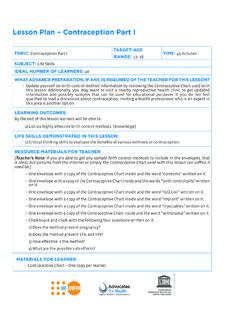

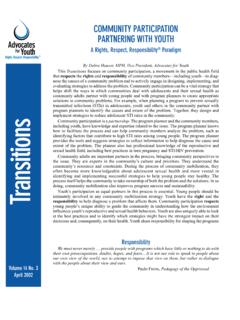
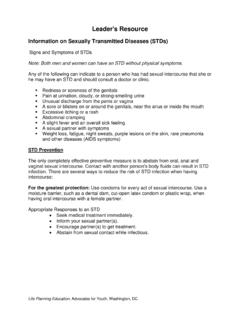

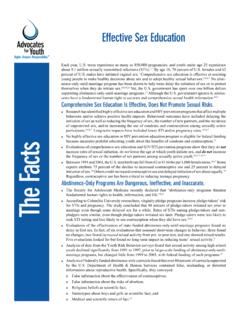
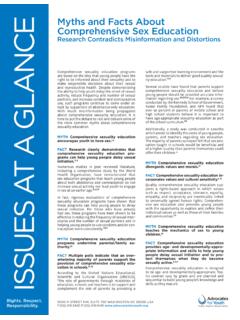


![Human Body Systems | 5E Lesson Plan for Grades 3-5 [PDF]](/cache/preview/5/3/7/d/5/f/0/a/thumb-537d5f0a980c7ec9133056914a11eb75.jpg)
